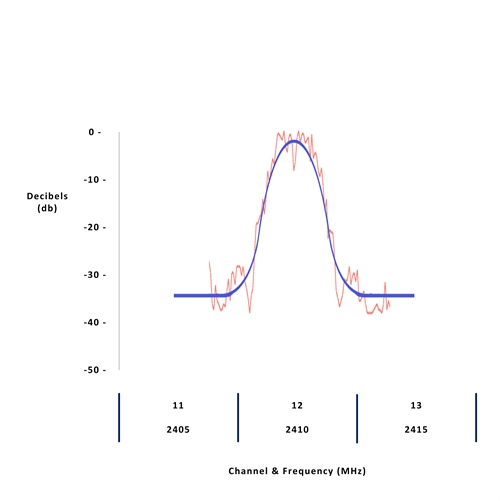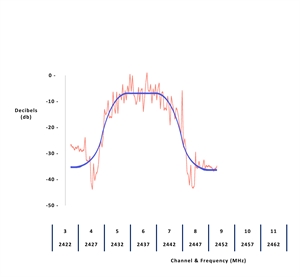Channels
The division of the frequency range into a number of separate channels is just for convenience, in preference to the networks being described by their actual frequency.
Different network protocols divide this frequency range into different numbers of channels:
| Network | Channels | Channel Width (MHz) |
| ZigBee | 16 | 5 |
| WiFi | 13 | 5 |
| Bluetooth | 79 | 1 |
The WiFi and ZigBee channels are not aligned, but instead differ by 2 MHz.
The numbering of the ZigBee channels starts at 11, because channels 1 to 10 are allocated to the lower frequency ZigBee channels, which are 868 MHz in Europe and 915 MHz in the USA.
The actual channels that are used by the control system for the ZigBee and WiFi networks are are defined during the installation of each network. The home WiFi channel will normally have been predefined separately by the user.
ZigBee Channels
The radio signals being transmitted by each network span a frequency range on either side of their center frequency, which is their bandwidth. The transmitted signals are heavily attenuated outside of this bandwidth, so as to minimize their interference with signals being transmitted on other channels.

For example, the network using channel 12 has a center frequency of 2410 MHz. ZigBee radio signals have a bandwidth of 2 MHz, so those on channel 12 are transmitted over the frequency range from 2409 MHz to 2411 MHz.
The red signal trace shown in this image is taken directly from a spectrum analyzer. The blue line is smoothed average, which emphasizes the overall profile of the signal attenuation relative to the nominal bandwidth.
The vertical scale on this diagram is shown in decibels. This is a logarithmic scale. At -30 db, the signal level is 1/1,000th of the peak value. This shows that there is negligible interference between channels. In practice, the background radio noise from many other sources is much greater than any interference from adjacent ZigBee channels.
As the ZigBee channels are 5 MHz wide, the center frequency of the next ZigBee channel, which is channel 13, is at 2415 MHz, as shown in this diagram.
In the configuration shown at the beginning of this page, two WiFi channels are used, one on channel 6 for the raspberry Pi, and one on channel 11 for the normal home WiFi. This leaves sufficient space on this 2.4 GHz band for 4 ZigBee channels, which are 11 through 14. Of these, channel 12 is used to run a network for the older AlertMe / 1st Generation Iris MSP network, and channel 14 is used to run a network for the modern HA and LL protocols. This additional channel separation further reduces the potential for any interference between the two ZigBee channels.
Phase locked loop technology is used extensively to receive radio signals, including ZigBee and WiFi. This technology enables the receiver to “tune-in” to a signal at a designated frequency, and to exclude all adjacent frequencies within a narrow bandwidth similar to that used for radio transmissions.
WiFi Channels
The bandwidth of a transmitted WiFi signal is about 20 MHz, which covers 4 WiFi channels. Most homes have only a single WiFi network, for which any channel can be used, and with 6 being the most common. A maximum of 3 WiFi networks can be run in the 2.4 GHz band with minimum mutual interference by using channels 1, 6 and 11.

In this example, the network using channel 6 has a center frequency of 2437 MHz. WiFi radio signals have a bandwidth of about 20 MHz, so those on channel 6 are transmitted over the frequency range from 2427 MHz to 2447 MHz.
The red signal trace shown in this image is taken directly from a spectrum analyzer. The blue line is smoothed average, which emphasizes the overall profile of the signal attenuation relative to the nominal bandwidth.
The vertical scale on this diagram is shown in decibels. This is a logarithmic scale. At -30 db, the signal level is 1/1,000th of the peak value. This shows that there is negligible interference between channels. In practice, the background radio noise from many other sources is much greater than any interference from adjacent WiFi or ZigBee channels.
Just as two ZigBee networks can operate on adjacent channels without any mutual interference, there is also no interference between WiFi and ZigBee channels, providing that their channels are adequately spaced.
In the configuration shown at the top of this page, the ZigBee network closest to these WiFi channels is on ZigBee channel 14, which corresponds approximately to the beginning of WiFi channel 3. At this frequency, the adjacent WiFi signal is attenuated well below -30db, which will not interfere with the signals on this ZigBee network. Equally, the ZigBee signals will not interfere with the signals on the WiFi network.
Increasing use is also being made of dual-band WiFi networks. This enables the 5 GHz WiFi band to be used, which frees up more of the 2.4 GHz band to accommodate more ZigBee channels.